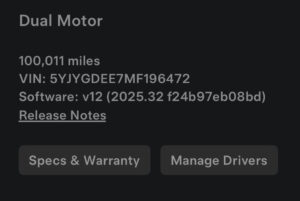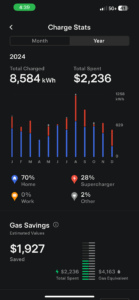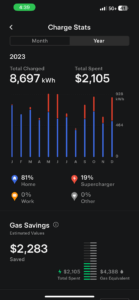When I bought my 2021 Tesla Model Y Long Range, I wasn’t trying to save the planet. I like the environmental angle, but really, I wanted to stop going to gas stations. I drive around 24,000 miles a year, and I have solar at home, so it felt practical. I wanted something with real range (over 300) and low upkeep. At the time, the Tesla Y and its network made the most sense.
The car started with about 327 miles of range. Now, after more than 100,000 miles, it’s just under 300. That’s normal. Range drops over time, and it’s worth factoring in before you buy. If an EV starts at 225 miles, a few years down the road, it might be 195. Add cold weather, and it’s even less. That’s not the car you want if you’re driving long distances every weekend. Four years ago, there was little charging infrastructure outside the supercharging network.
For me, planning trips is part of the routine. I visit family in the Philly area and shoot weddings all over the East Coast. I map everything out before leaving to never have range anxiety. Here’s a tip: if you’re doing a long round trip, set your home as both your starting and ending location, and then add your destination stops along the way. That way, you’ll never end up short on charge at the end of a long day.
Most of the time, Tesla’s Supercharger network has made it easy. I’ve only gone under 10 miles of range a few times. I’ll usually stay a bit longer when charging to make sure that doesn’t happen again. Quick stops are for bathrooms, but sometimes, especially late at night, I’ll catch a nap while it charges.
Over time, I’ve saved around $8,200 in gas, but I do go through tires about once a year. That’s the cost of EV torque, instant power, and heavy weight. Still, other than tires and a windshield deductible, I haven’t paid for any repairs. I’m due for brakes, but regenerative braking has stretched their life far beyond what I’d expect in a gas car.
Winter driving is better than people think. Even without snow tires, it does well. With them, it’s excellent. Range dips a bit in the cold, but not nearly as bad as some other EVs.
Not everything’s perfect, though. The Tesla isn’t luxury. After 100,000 miles, the steering wheel and handles show wear, and I’m less aggressive driving now because I know tires are expensive. There’s also the “Elon factor.” Owning a Tesla comes with an ick factor now. I’d buy an equivalent EV if I could, but not a Tesla. Nothing under 300 miles of range, though.
If you’re thinking about switching to electric, here’s my honest advice:
It’s fun. Range anxiety isn’t really a thing anymore if you can get a car with decent range, but EVs do take a little more planning. Don’t buy one unless you can charge at home. Supercharging can be more expensive than gas, and resale value drops fast, so don’t overpay. If you can, get a used one with low miles. Every model has its quirks. Do your research and find real owner experiences.
And maybe most importantly: understand the bigger picture. The shift to EVs is being held back in the U.S., Europe, and Asia already have better options and more variety. We’re being played by limited supply and inflated pricing. The tech is ready, but the market isn’t being honest about it.

Still, after 100,000 miles, I’d say this: driving electric still feels like the future with its quiet, quick, and efficient ride. I just wish that the future were being rolled out a little more fairly.


Charging details from the last year or so.

Christopher lives in Vermont with his wife, twin boys, border collie and corgi. He has owned a film production company, sold slot machines, and worked for Tony Robbins. He writes in his magical tiny house and sometimes writes in his blog at chrisrodgers.blog
Visit his author’s page.